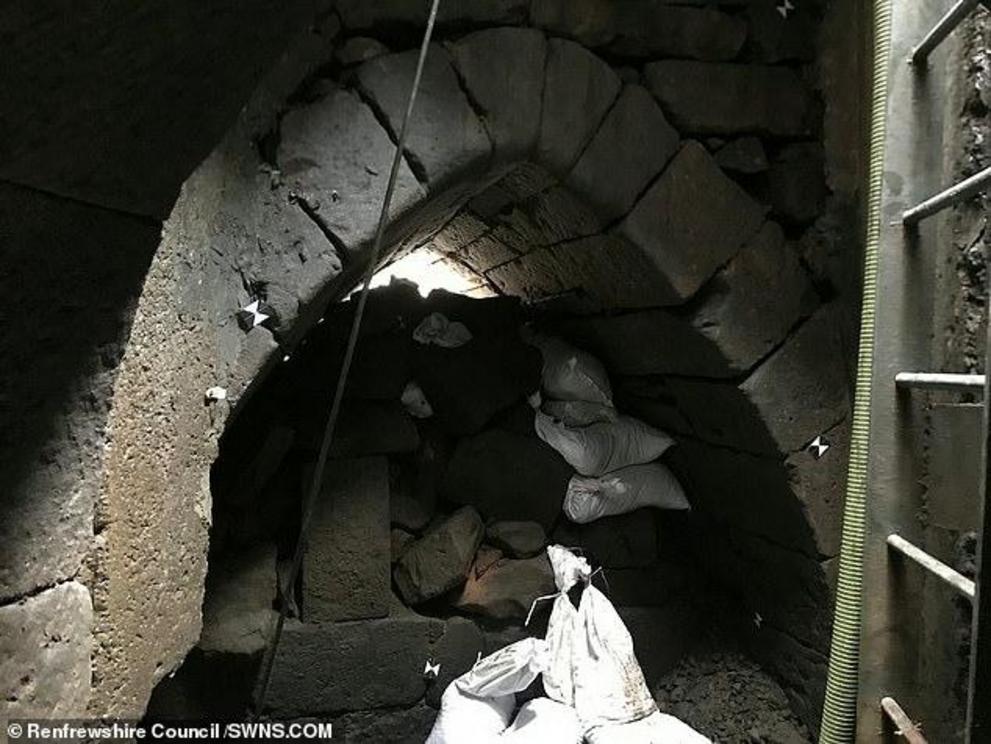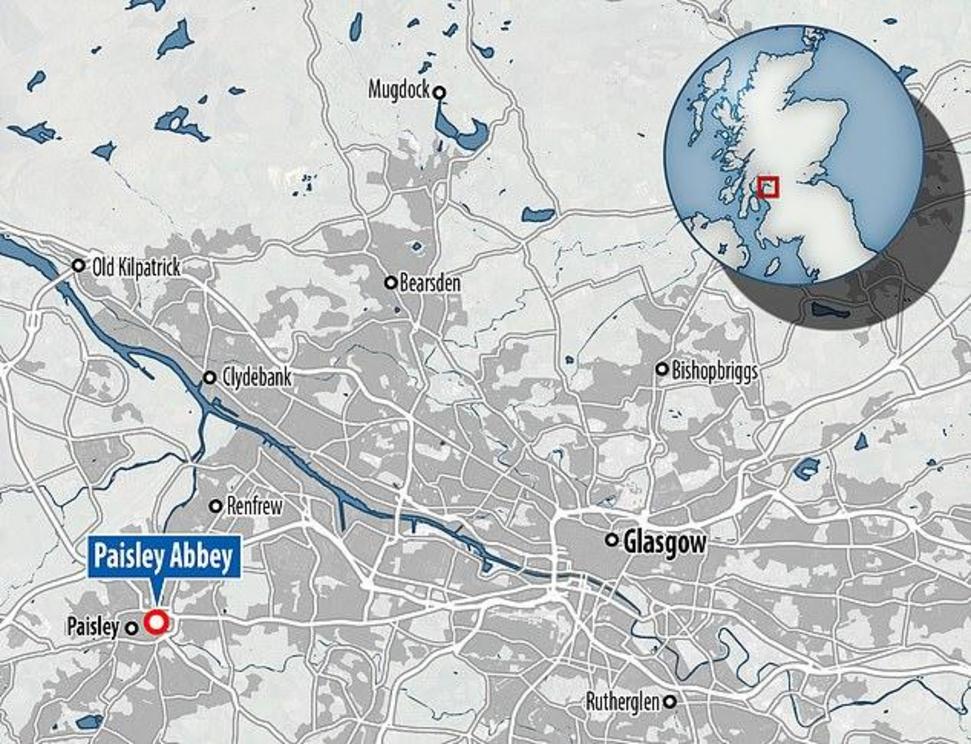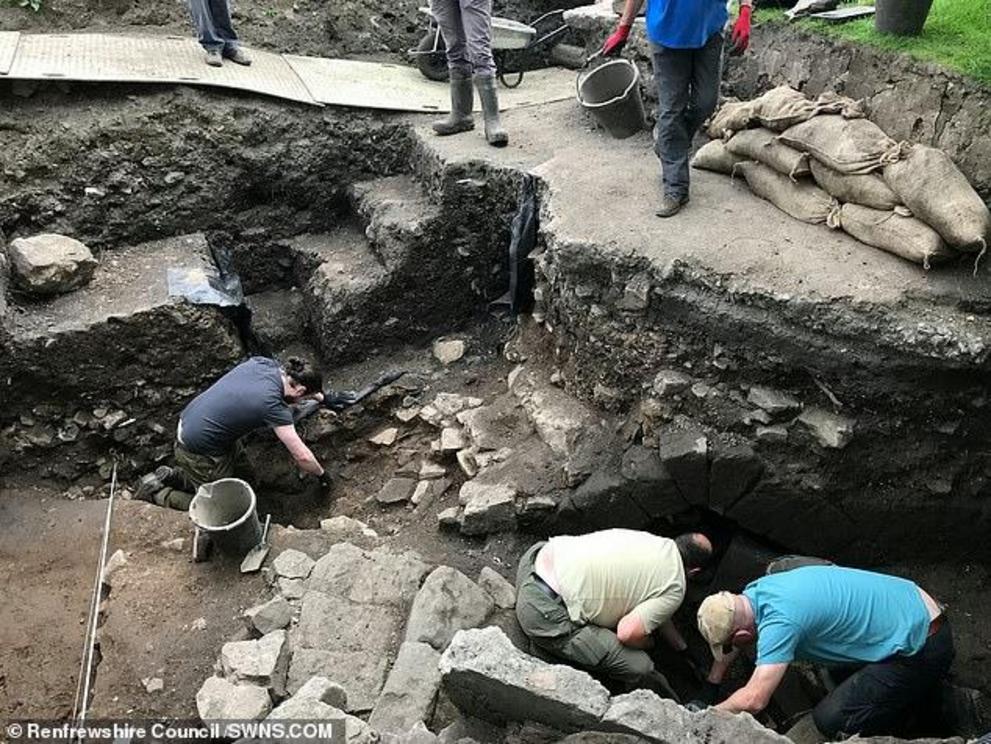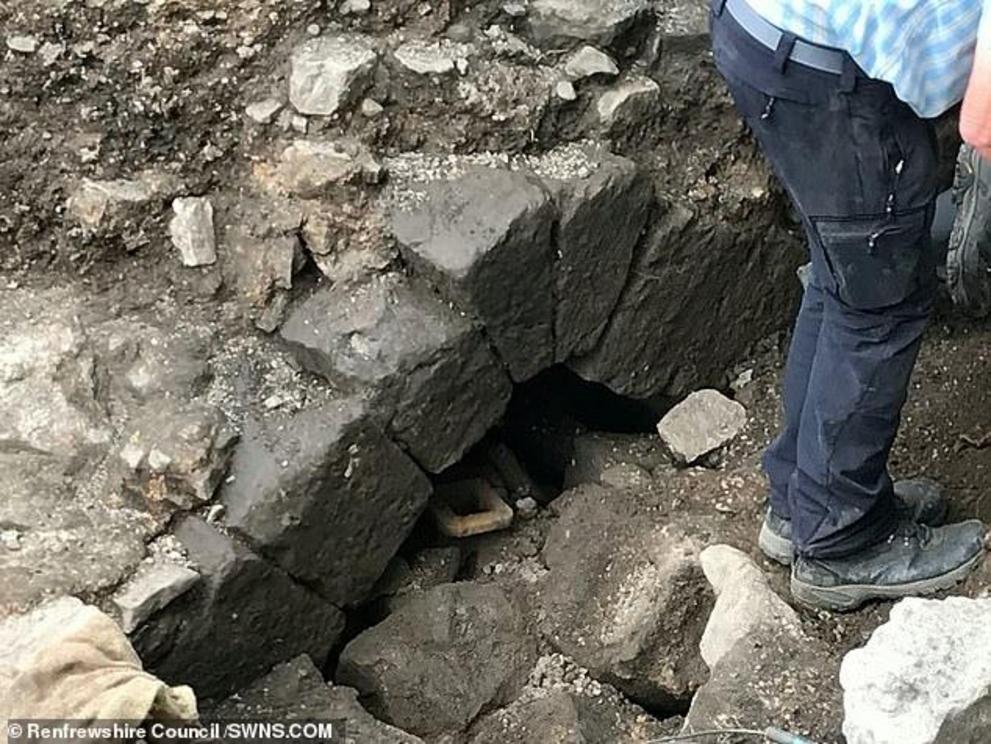Medieval drain measuring 300ft long found in Scotland is one of the country's best preserved tunnels and dates back to the 14th century
- 14th century medieval remnant was found beneath Paisley Abbey in Scotland
- The 300ft long stretch of drain tunnel ended near the present-day river
- It is thought the drain tunnel would have reached the river when it was built
- Drain is now being covered up again but could lead to a future visitor attraction
A stunningly well-preserved 300ft long stretch of drain tunnel has been discovered in Scotland and is being heralded as one of the best preserved examples ever found.
The 14th century medieval remnant was found beneath Paisley Abbey and a summer project has seen it carefully uncovered.
They found the tunnel ends around ten feet (3m) from the banks of the present-day river, which would have been wider and shallower at the time the drain was built.
The find is now being covered up again, but the discovery could help lead to a more permanent visitor attraction opening up access to the drain in the future.
 The 14th century medieval remnant was found beneath Paisley Abbey and a summer project has seen it carefully uncovered (pictured). They found the tunnel ends around ten feet (3m) from the banks of the present-day river
The 14th century medieval remnant was found beneath Paisley Abbey and a summer project has seen it carefully uncovered (pictured). They found the tunnel ends around ten feet (3m) from the banks of the present-day river
The eight-week Abbey Drain Big Dig was coordinated by Renfrewshire Council and led by Guard Archaeology Ltd.
More than 6,500 people visited the dig over the eight weeks, which also saw a strong community element, with volunteers from the local history forum taking part, and a series of events and seminars for residents and visitors.
Dig leader Bob Will of Guard Archaeology described the condition of what the team found as 'incredible'.
He said: 'We found more than I was expecting and it is really exciting.
'We found the end of the drain and what was the boundary wall of the monastery.
'The river was wider and shallower in those days - much more than in the last couple of hundred years, as the walls now surrounding it are artificial.
'The main parts of the drain date back to the mid-14th-century and are incredibly well preserved.
'It goes as least as far as the road in front of Renfrewshire House.
'Often these types of drains are in rural areas not urban ones where there will have been pressure on the land above it.
'But considering the amount of buildings on that site over the centuries, the condition of the drain is quite incredible.'
 More than 6,500 people visited the dig over the eight weeks at the site of Paisley Abbey near Glasgow
More than 6,500 people visited the dig over the eight weeks at the site of Paisley Abbey near Glasgow
 The eight-week Abbey Drain Big Dig was coordinated by Renfrewshire Council and led by Guard Archaeology Ltd. The find is now being covered up again, but the discovery could help lead to a more permanent visitor attraction opening up access to the drain in
The eight-week Abbey Drain Big Dig was coordinated by Renfrewshire Council and led by Guard Archaeology Ltd. The find is now being covered up again, but the discovery could help lead to a more permanent visitor attraction opening up access to the drain in
 The Abbey Drain has lain hidden for centuries until it was unexpectedly rediscovered in the 19th century, and in recent years, it has been periodically opened up for visitors
The Abbey Drain has lain hidden for centuries until it was unexpectedly rediscovered in the 19th century, and in recent years, it has been periodically opened up for visitors
The Abbey Drain has lain hidden for centuries until it was unexpectedly rediscovered in the 19th century, and in recent years, it has been periodically opened up for visitors.
Bob believes the finds of the past few weeks could help the development of a more permanent attraction opening up a greater degree of public access to the drain.
He said: 'What we have uncovered has helped us see what could be done with any future excavation.
'We now know much more about the medieval ground levels and have a good idea where some of the monastery buildings were.
'Ideally there would be more permanent access to the drain at some point in the future and what we've uncovered here makes that much more feasible.'
Renfrewshire Council leader Iain Nicolson said: 'We would be keen to explore any opportunities to build on that by opening up more permanent access to the Abbey Drain at some point in the future.
'The findings of the Big Dig mean we now know more than ever about this incredible feature beneath the town centre.
'The Big Dig was a really great community project which has created a lot of interest in Paisley town centre and its history over the past couple of months.
'We would like to thank our funders for helping make it happen, and all who have been involved in the projects - particularly the local volunteers who came out in all weathers to take part.'
WHAT IS PAISLEY ABBEY?
Paisley Abbey was founded by thirteen monks from Much Wenlock in Shropshire.
The priory was set up on the site of an old Celtic church founded by St. Mirin in the 6th century.
In 1245, the priory was raised to the status of an Abbey, answerable only to the pope in Rome.
Under royal patronage, the Abbey became wealthy and influential and evidence exists of extensive trade between Paisley Abbey and commercial centres throughout Europe.
The Abbey was also a centre of learning and it is believed that William Wallace, who played a prominent part in the Wars of Independence in the 13th century, was educated by the monks of Paisley Abbey.
Much of the original building was destroyed by fire in 1307 and restored during the fourteenth Century.
The Abbey claims to be the 'cradle of the Royal House of Stewart' as King Robert II of Scotland, the first of the Stewart monarchs, was born there.
At the Scottish Reformation in 1560, the monastery was disbanded, the monastic buildings handed over to the Hamilton family and the walled-off nave became the parish church of Paisley.
